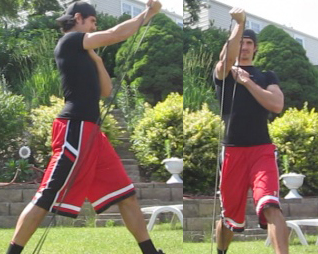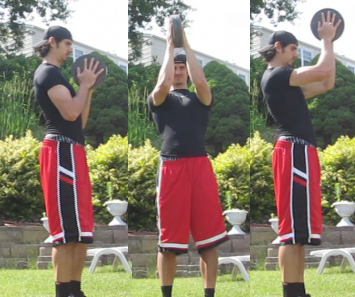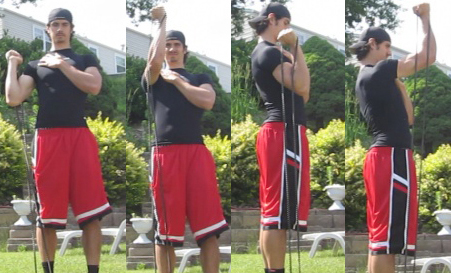You know those cool polyester shirts that feel oh-so-awesome in the summer time? The super athletic ones? The ones you buy twelve of because they look awesome in the store? Yeah, I do too. Even though I don’t wanna. Because, despite my seeded desires, when I wear them, I somehow grow a pair of tits. [...]
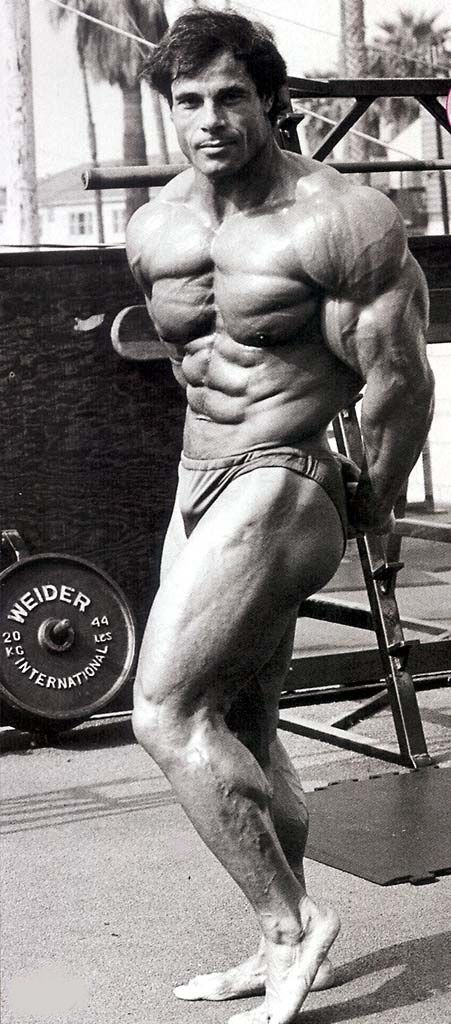 You know those cool polyester shirts that feel oh-so-awesome in the summer time? The super athletic ones? The ones you buy twelve of because they look awesome in the store?
You know those cool polyester shirts that feel oh-so-awesome in the summer time? The super athletic ones? The ones you buy twelve of because they look awesome in the store?
Yeah, I do too.
Even though I don’t wanna.
Because, despite my seeded desires, when I wear them, I somehow grow a pair of tits. With hard nipples, to boot.
A Ron Burgundy blame-it-on-the-pleats optical illusion?
Perhaps.
But it doesn’t matter
The biggest sore spot for most guys has gotta’ be the upper chest. Wimpy arms are liveable. But being collapsed under the collar bone? Talk about a downer.
The upper chest is a life changer. It affects the clothes you wear and how confident you feel. Every. Damn. Day.
I know how you feel. Let’s fix it together.
Now, I don’t want to fool you: I don’t have a model upper chest. My pressing strength isn’t ideal either. But I’m writing this anyway because you can learn from my failures, and I’ve never seen an upper chest article that focused on principles rather than exercises.
I’ve listened to anecdotes about “just getting the bench press stronger” to fix my woes. But at my pressing peaks I was just as unsatisfied with my upper chest as I was at my pressing lows.
Writing about Evosport and long duration isometrics made me realize that I reprogrammed my glutes like a champ over the past few years.
Couldn’t similar concepts apply to the upper chest? Couldn’t it be repatterned to increase activation? Wouldn’t that then lead to greater size?
To give you a hint, I’m two weeks into this little “experiment” and my chest is the most proportionate it’s been in my life. Things are looking good. Here’s how you can say the same thing.
IS ISOLATING THE UPPER CHEST A MYTH?
 Some say preferentially building the upper chest is impossible. Instead of butchering the words of Dr. Clay Hyght, I’ll just quote this piece from Building a Bodybuilder Chest:
Some say preferentially building the upper chest is impossible. Instead of butchering the words of Dr. Clay Hyght, I’ll just quote this piece from Building a Bodybuilder Chest:
You may have heard of the “all or none” principle of muscle contraction. Essentially, here’s what it means: When stimulated, a muscle fiber will either contract or it won’t.
Some people have erroneously adapted the all-or-none principle to mean that an entire muscle will either contract or it won’t. These confused individuals will go on to tell you that exercise variations are practically pointless when training the chest because the entire pectoralis major will either contract or it won’t.
This is some seriously misguided logic to say the least.
For starters, although still considered part of the pectoralis major, the clavicular pectoralis is actually a separate muscle with a separate nerve innervation.
Although the entire sternal head of the pectoralis major does share a common nerve innervation, the angle of the muscle fibers varies tremendously from top to bottom. For that reason, the line of pull is different throughout different areas of the muscle.
Luckily for us, your body (or brain rather) will recruit or call upon the portion of the muscle that’s best suited to perform the movement in question. So if you were to do a movement in which the lower fibers of the pectoralis major are in the best mechanical advantage to execute the movement, then those will be the primary fibers recruited to do the work —thank goodness!
So yes, you can emphasize different sections of the chest from top to bottom. But notice I said emphasize, not isolate!
So fixing the upper chest starts with repatterning the clavicular pectoralis—the triangle shaped muscle that creates the upper chest. Just like people do with the glutes, the goal is to better recruit the upper chest in every pressing movement. This hinges on two things: increasing overall activation, and using optimal mechanical positions during lifts.
HOW TO INCREASE ACTIVATION
In my X Physique article, I touch on the bodybuilder mindset.
When it comes to lifting weights, the goal is to continually overload the muscles. The easiest and most trackable way to do this is by slapping more plates on the bar. The problem with this philosophy is that the muscles become secondary to the weight.
But the muscles are what actually lift the weights.
…
But when dealing with “carving” a physique, Arnold said it best: “The weights are just a means to an end; how well you contract the muscles is what training is all about.”
…
Control the weight, mentally and physically, through-out the entire range of motion. Make the muscles work in every phase. Think about them squeezing and lengthening.
Research proves that a greater mental connection with a muscle results in a greater activation. Old time bodybuilders will back that up. So instead of thinking general overload, think specific overload. It’s less about pressing and more about the upper chest. You no longer press. You power through a movement with the upper chest. Here’s how to make this happen.
1. I credit this to Frank Yang. During every repetition of every lift, picture your body as nothingness except for the muscle you’re targeting. Check out the anatomy dude above. Envision that. Seriously. Try it. It works. Close your eyes and practice it before every set. Think of the targeted muscle lighting up bright red in a sea of white.
2. Pre-exhaust the upper chest with an abundance of activation exercises (see below) before any bigger pressing movement. Yes, your performance will drop on the bigger pressing movement. No, it doesn’t matter. The goal is to specifically overload the upper chest.
3. Do unilateral lifts. Put your hand on the upper chest of the arm at work. Feel it contracting. This sensory connection helps.
4. Start with isometrics. When trying to activate, don’t go too complex too soon. You need time to think about what’s going on — time to develop the connection with the mind. Dynamic contractions don’t often afford this.
5. Keep stress on the muscle at lockout. Too often, lifts are locked out with the joints. Learn how to lockout a lift and still feel the stress in the target muscle.
HOW TO TAKE ADVANTAGE OF MECHANICS
The upper chest has two main functions: flexion (think of raising your hands) and horizontal adduction (think of clapping hands together). This means two things:
1. The elbows should be pinned to the rib cage during most (if not all) pressing.
2. It’s best to press in an upward and inward diagonal plane.
But we can’t stop there…
3. If a lift doesn’t target the upper chest, don’t do it. This means parting with both dips and bench presses. Deal with it for now. As Dan John says, “The goal is to keep the goal.” Down the line, if you even things out, go back and own those exercises.
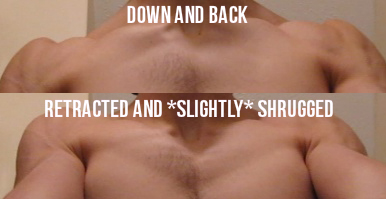
4. Pack the shoulders in the correct position for optimal upper chest activation. Keeping them “back and down” opposes both of the upper chest’s main functions. Practice this by putting one hand on the opposing side’s upper chest, retract your scapula, and shrug your shoulder blade around. You will hit a position with the upper chest fairly active. This is your new lockout position. See #5 below for why.
5. Live on unilateral dumbbell exercises. According to Frederic Delavier, author of the Strength Training Anatomy books, “With bilateral work, both shoulders are driven backward supporting the weight, putting them on stretch and causing greater delt recruitment. Working one side at a time means using less weight, therefore the shoulder stays in place and doesn’t get as involved.” (The above information was taken from Sean Hyson’s blog post, Bodybuilding That Isn’t B.S.)
6. Shallower inclines may be better than steeper inclines. The latter tends to put more emphasis on the shoulders.
7. Don’t ever flare your elbows on any pressing.
8. Take the muscle through a fully stretched range of motion. This is a toughie that’s better explained during some of the actual exercise descriptions below.
9. On dumbbell presses, rotate the wrists when nearing the lockout so that the pinky fingers face towards the body. This adducts the arm — a function of the upper chest.
10. Try pressing in an arc. Understand the function of the upper chest: think of clapping and raising your hands at the same time. So to stretch the muscle you have to oppose this movement, which means bringing the arms down and out a bit. But to shorten it, it has to be returned to the clap position which means the arms not only have to drive away, but also up towards the head.
CHOOSING THE RIGHT EXERCISES
All of the numbered points above form the philosophy of building the upper chest. All of the exercises listed below, in some way, abide by the guidelines above. They are broken down into two categories. Activation exercises are used frequently to awaken the upper chest. Base exercises are more readily overloaded, making them better suited to traditional training guidelines.
As you read through these exercises, don’t forget mechanics and activation sections above. For instance, the elbow will always be in tight. Top half range of motion is often shorter. Remember, we aren’t pressing. We are overloading the upper chest. Flexing the arm above a certain point shifts the focus to the shoulders. That’s a no no. All focus stays on the upper chest.
CHOOSING THE RIGHT ACTIVATION EXERCISES
1. Isometric Band Work
On of the simplest ways to get the upper chest to fire is with isometric-esque band flies. I prefer hooking the band around a doorknob or something waist height, not necessarily under the foot as shown in the picture.
Put your non-working hand on the opposing side’s upper chest to make sure it’s doing it’s thang. Get maximal tension in the band and press into a psuedo-lockout. Rotate the wrist so the pinky faces the midline of your body. From here do little “pulses” bringing the band both up and across your body. Range of motion will be teeny tiny. The goal here is to increase blood flow to the area and to familiarize yourself with what it “feels” like to fire the upper chest.
2. Hyght Flies
Hyght flies are named after Dr. Clay Hyght, who has written extensively about the upper chest. Once again, I’ll let him do the talking:
My purpose for creating the exercise was to target the clavicular pectoralis with its most pure function, which is to fle (raise the arm up) and horizontally adduct (move toward the midline) the shoulder joint.
Begin by lying on your back on a bench inclined to about 60 degrees. After grabbing a light set of dumbbells. begin the movement with your arms hanging straight down and your palms facing forward. Initiate the movement by bringing your arms up and in across your body.
Think of forming a triangle with the path of the dumbbells, with the point of the triangle (the finished position) up over your nose. I have found it optimal to have the pinky side of the dumbbbells come together, forming a 90 degree angle. Make sure to perform the movement by pulling with your upper pecs, not the shoulder or biceps.
Just to note, Dr. Hyght finishes with an interesting note: pull with the upper pecs. This goes back to learning how to pack your shoulders correctly for optimal upper chest activation as mentioned in #4 of the mechanics section.
3. Modified Svend Press
Smash two plates together and hold them in front of your body. Instead of pressing them straight out, like in the regular Svend Press, press them up. Keep the elbows in tight. This isn’t really a “press.” It’s more of a front raise. Keep the stress on the upper chest.
4. Band V Press
The band v press is a great exercise because it fully stretches the upper chest at the bottom. Notice the start position. The elbow isn’t in tight, and the wrist is pronated. Focus on ripping the clavicular pectoralis from the bone to get a good stretch.
For the actual movement, bring the elbow in and rotate the wrist with the press. You can also press “out” at a 45 degree angle to get more tension on the band..
CHOOSING THE RIGHT BASE EXERCISES
1. 30 degree, Low Incline, Close Grip Incline Barbell Press
Throw away all other barbell pressing. Compared to a flat press, the upper chest isn’t necessarily recruited all that much more, but the lower chest is less recruited. Using the close grip and the shallow incline makes it all the better.
Note: The low incline is preferred to a higher incline because higher inclines tend to shift the focus to the shoulder.
2. 30 degree, Low Incline, Incline Dumbbell Press
Perhaps even better than incline barbell pressing is incline dumbbell pressing. Dumbbells make it easier to keep the elbows in tight, get a good stretch, and press in an arc up over the face.
You can also twist the dumbbells so that the pinky finger’s face each other at the top of the movement — perhaps even touching them and doing an isometric squeeze — to involve more of the upper chest.
Also, keeping in mind #5 of the mechanics section, it might be beneficial to do all of your dumbbell pressing unilaterally. Keep the non-working hand on the upper chest of the working arm.
3. 30 degree, Low Incline, Incline Fly
Flys can be good. They can also be bad if you don’t know how to pack the shoulders correctly (see #3 of the mechanics section). Keep the stress on the upper chest. Stay humble with the weight on this exercise.
4. 30 degree, Low Incline, Incline Squeeze Press
http://www.youtube.com/watch?v=6PFlUoup01Y
This exercise comes from John Romaniello. Squeeze two dumbbells together as hard as possible while doing incline presses. Keep the elbows in tight and emphasize pressing in an arc on this exercise. So bring the bells down to the nipple area and press them up to a position over your face.
5. Low to High Cable Fly
You can check out the interworkings of this exercise here.
6. Unilateral Dumbbell Floor Press
If I had to pick a “go to” exercise to learn how to properly pack the shoulder for upper chest activation, this would be it. Read about this exercise here.
7. The V Press
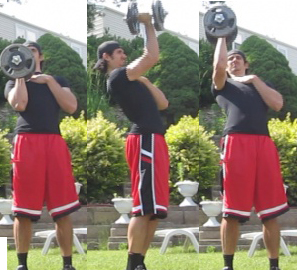
I “invented” this exercise in attempt to have a moderately overloadable exercise that would stretch and stress the upper chest in a way that met most of the guidelines above.
For this press, go through full range of motion at the bottom. Think about poking underneath of your collar bone with your thumb. As with most other exercises, keep the elbow in and only press as far as your upper chest can control.
8. Front Shoulder Raise With Thumbs Up
Raise the arms until they are 15 degrees above parallel. Do these with a plate and squeeze it during the reps.
THE INS AND OUTS OF REPATTERNING PROGRAMMING
As you know, I’m more of a minimalist when it comes to exercise selection. So don’t be confused by the wide array of exercises above.
I know that the bulk of our progress is going to come from a few things:
- Increasing activation
- Using and understanding proper mechanics
- Avoiding any pressing that doesn’t preferentially hit the upper chest
- Leveling up one or two big exercises over time
You can do all of the pump work you want, but if you aren’t continually overloading the incline press or one of the dumbbell presses while adhering to proper mechanics, your progress will be sub-par.
So the plan shakes out like this:
1) Do one of the activation exercises every day. You can rotate though if you want. Incorporate some kind of isometric contraction with each movement. For instance, do the modified Svend press with a five second pause at the top.
Something like three sets with 10-20 repetitions is ideal for these. If you want, do a different one every day. Do them more than once per day, too. When improving activation, frequency is fantastic. But, remember, the goal is always to increase the “feel” throughout the upper chest. Have your mind in every repetition.
2) Pick either the barbell incline press or the dumbbell incline press and use that as your marker of improvement. So whichever you choose, focus on progressive overload over time. This doesn’t mean busting a maximal load every session. Sometimes you will need to sketch. But over the span of your training life: More weight. More reps. Less rest in between sets. Whatever. Just make sure you’re using proper mechanics.
Putting up an extra twenty pounds doesn’t matter if you’re squirming around like a salmon under the bar. Building the upper chest is a gut check. Only those that throw their ego aside will prosper.
3) Stick with high(er) repetitions. On the big lift(s) chosen above, stick with the 6-10 range. It’s light enough to ensure form. Heavy enough to be “heavy.”
4) Consider specializing. This may sound off to some, but think about training the upper chest three times per week. Even bolder, think about training it every day. There’s a template for this below, but it comes down to doing one base lift submaximally every day. You can recover as long as you play your cards right. Trust me.
5) Take smaller jumps during a warm-up. For example, if you’re working up to an incline bench press of 185 for 6 reps, your warm up might look like this:
45×6
65×6
95×6
115×6
135×6
155×6
185×6
Then, depending on your preferred method of overload, you can do sets across at your maximum weight, drop sets, whatever. (Or just stop there as that’s a hefty workload.) But, for the most part, the warm-up is the bulk of the workout because you don’t want to take a sudden jump that makes it difficult for you to maintain proper upper chest recruitment.
NORMAL GUY SAMPLE ROUTINE
Most guys train pressing once or twice per week. So here are two workouts. If you only train once per week, simply rotate through the workouts. So the first week, do the first workout listed. Week two, do the second. If you train twice per week, you’re good to go.
Every morning: 3 sets of 15, band v press, 5 second isometric hold at maximum contraction
Pre-exhaust (done right before pressing sessions): 3 sets of 10, modified Svend press, 5 second isometric hold at top
Workout A
Incline Barbell Press, work up to a heavy set of 8
V Press 3×15
Low to High Cable Fly 1x failure
Workout B
Unilateral Dumbbell Floor Press 4×6
Unilateral Incline Press 2×15
Low to High Cable Fly 1x failure
HIGH FREQUENCY SAMPLE ROUTINE
For the high frequency routine, it’s best to have two “main” pressing sessions per week.
Every morning: 3 sets of 15, band v press, 5 second isometric hold at maximum contraction
Pre-exhaust (done right before pressing sessions): 3 sets of 10, modified Svend press, 5 second isometric hold at top
Daily Workout
V Press 3×10
-Done with a weight that could be handled for 15-20 repetitions
Workout A (Tuesday)
Incline Barbell Press work up to a heavy set of 8
Workout B (Friday)
Unilateral Incline Press 4×8
BONUS: BODYBUILDER SPECIALIZATION ROUTINE
Every morning: 3 sets of 15, band v press, 5 second isometric hold at maximum contraction
Pre-exhaust (done right before pressing sessions): 3 sets of 10, modified Svend press, 5 second isometric hold at top
Workout A (Monday)
Unilateral Dumbbell Floor Press 4×6
V Press 3×15
Workout B (Wednesday)
Unilateral Incline Press 2×15
Low to High Cable Fly 1×15
Workout C (Friday)
Incline Barbell Press, work up to a heavy set of 6
Mechanical Drop Set, 3 sets
- Do a set of incline flies to near failure. Without putting the dumbbells down, go right into incline dumbbell presses.
CONCLUDING REMARKS (AND MY PROGRAM)
The exercises listed aren’t special by any means, but that shouldn’t be surprising. Instead, focus on the principles: Not doing bench presses or dips. Keeping the elbows tight and in. Trying to press with an arc. Getting the upper pecs to fire better. Only using the range of motion controlled by the upper chest.
And as for the absurd amount of activation work, keep it around for about eight weeks. After that, tone it down to warm-ups and perhaps a mild pre-exhaust.
For those of you wondering where to include overhead pressing, ditch the second workout on the Normal Guy and High Frequency templates. Do your overhead presses there. But the specialization routine is “specialized” for a reason. Forego the overheads for the time being if you want to walk that path.
As far as the training program I’m currently on and seeing results from — it’s essentially the high frequency program. I’m in the summer haze of lifting every day, which calls for incline pressing to a moderate intensity 3-4 times per week. But I do v presses daily along with the activation work. Very sketchy. But, so far, very productive.
UPDATES AS OF 6/11
KEEPING “TUCKED” SHOULDERS
Keeping the shoulders close to the torso (or using a close grip) activates the upper chest because it adducts the arm. Self guided research by Bret Contreras showed that close grip bench presses active the upper chest nearly as much as incline pressing.
Keeping the elbows close to the torso is difficult on barbell exercises because the wrist is pronated (to hold the bar). So try holding them to a flare of 15-30 degrees. On dumbbell exercises, however, keep the elbows in tight. No more than 15 degrees of flare.
This puts more emphasis on both the shoulders and triceps, which is fine. If you’re worried either will fatigue before the upper chest gets “enough” work, consider intensive pre-exhausting with any of the activation exercises listed above.
THE 242 PROGRAM
If you follow The 242 Method, here are some ideas:
Pick either the dumbbell or barbell incline presses as your main marriage lift.
On your low intensity days, pick any of the dumbbell exercises. Do them with a controlled tempo, short of failure. Focus on engorging the upper chest with blood. Get jacked. Simulate. Don’t annihilate. Incline squeeze presses, incline flies, unilateral dumbbell floor presses, and low to high flys all work well here. Try ‘em all. See what ones you can best get a mental connection with. Stick to higher reps .
THREE NOTES ON THE V PRESS
First, by nature of the movement, your lower back will be hyperextended. This freaks some people out. But old school pressers used to hyperextend the back a lot. I don’t find it a big deal as long as you do two things: squeeze the glutes and lock the abs. This creates a solid base to work from and will protect your spine.
Second, don’t just press up. Press out. I called it the V press because the angle of your body and arm form a “V” of sorts. This hits another one of the upper chest’s functions: shoulder flexion.
Now, don’t go extreme. Too far out limits the weight you can use. The goal of the V Press isn’t activation, it’s overload. (As long as the upper chest is the muscle doing the main work.) This takes some experimentation, but you might only be pressing 5 degrees out of the vertical plane.
Third, don’t think of this exercise as a “jab.” Most people are jab pressers that drive movement from the triceps. If you’re privy to fighting, think of the V press as more of an uppercut. Don’t really focus on the “extension” part. Drive from the shoulder and upper chest.
Uppercut. Don’t jab. Maybe I should have called it the uppercut press?
+++++
What do you think? Have any exercises that didn’t make the list? Any principles that I overlooked? I’d love to hear your opinion, so shoot a comment below.
Update: since first writing this, I’ve made something that you probably should check out if this post interests you. It details a full repatterning program and some great exercises that you can use — it’s sort of a polish and expanded upon version of all of this. I call it A Mortal Man’s Guide to Building a Masterful Upper Chest. Just some of the things I’ve learned over the years.
